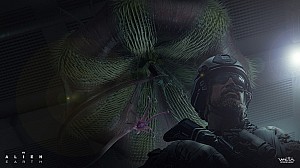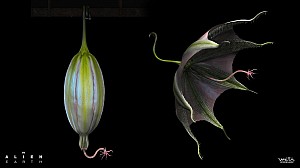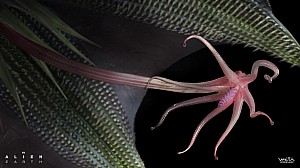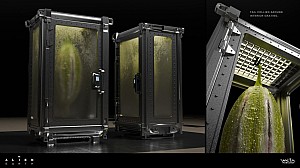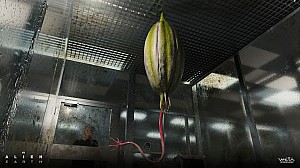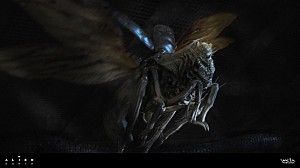ADI claims to have redesigned Giger's Alien. By Tim Prokop

Central to director David Fincher's concept for Alien 3 was the premise that the Alien take on some of the characteristics of its host. It was initially planned that the Alien would develop within an OX, but this was later changed to a dog. As a result, the Alien that terrorises Fiorina 161 is a quadruped , equally at home on both two and four legs.
The task of realising the new Alien and showing it's evolution from birth to maturity fell to Tom Woodruff and Alec Gillis of Amalgamated Dynamic Incorporated (ADI), who had been key members of Stan Winston's effects team for Aliens.
"The Alien was so well known that there wasn't a lot we could do with it except try to make it look eve more Alien than in the first two films," explains Woodruff. "Most of our changes were stylistic because we really wanted to go back to the original paintings and designs for Giger, which hadn't been fully realised."
"Giger's paintings tap into something that's frightening and at the same time very fascinating," adds Gillis. "Things like car parts and mechanical features are integrated loosely into his original designs for the Alien, and I think this weird combination of human, machine , and bone is one of the things that make it so unique and terrifying. We tried to suggest these same shapes, but in a very organic way."
Gillis and Woodruff were in London preparing for the films when they were surprised by a telephone call from Zurich. "When we were told it was Giger on the line, we really didn't know what to expect," says Woodruff. " We've been fans of his work for years, but we'd heard a lot about him being temperamental, and we didn't know whether he liked or hated what we did for Aliens. We didn't know if he was calling to congratulate or abuse us", Woodruff laughs. "As is turned out, he couldn't have been nicer."
Gillis concurs, "The Alien is Giger's baby, and he was calling to find out what we planned. After that, we stayed in contact and he faxed drawings and ideas that proved very helpful when we were deciding how the Alien was going to develop. We all seemed to be on the same wavelength in terms of the direction in which we were taking the character."
One example of this is the decision to dispense with the long extensions of bone that had adorned the Alien's back in the first two films. Woodruff and Gillis made the decision to remove the tailpipes for practical reasons, because with the Alien on all fours, they interfered with the movement of the head. The day they made this decision they received another call from Giger. "He called to say that he hoped we'd get rid of the tailpipes. He'd just put them there to breakup the human form of the suit and had never liked them. It was a very welcome coincidence."
The suits for Alien 3, which were worn by Woodruff, were created absolutely skintight to prevent and wrinkles or bulges that might betray their foam latex origins. For the same reason, there were no zippers or flaps on the body section, which meant that Woodruff would sometimes go up to 10 hours at a stretch without being able to relieve himself. Woodruff, a veteran suit performer, accepted the hardship as an essential part of ADI's effort to create a truly classic screen monster.
"The scenes where the Alien rampages through the flaming prison complex were among the most difficult that Woodruff had to perform, Gillis recalls. "They laid down a lot of flame bars, and at timers, it got so hot that the slime was evaporating right off Tom's suit. A couple of times we had to call a stop and pour cold water over him to stop the heat from penetrating. To supplement the suit, a striking head with the inner jaw operated by a pneumatic ram was created for close ups of the Alien's attack on it's victims, while the task of creating an Alien that could stand up to a wider camera angle experts at Boss Film Studios, under the supervision of four-time Oscar winner Richard Edlund."
Woodruff and Gillis created a mold for a 40-inch Alien rod puppet, which was cast in foam at Boss. An armature made from bicycle chain was installed to provide directional, easily controlled movement for each limb. Laine Liska, a former stop-motion animator, was chosen as lead puppeteer because of his experience of creating life-like movement. Two weeks of intensive testing allowed Liska to determine the best arrangement to operate the puppet. "We inically tried it with the body of an Alien on motion control, but it moved more like a bunny rabbit than an Alien," explains Liska. "It really started working when we started doing everything by hand, including running the puppet along a ramp so it covered distance as it moved."
Liska adds, "Most of the time there were four of us working the puppet one person on the front legs, another operating the tail and me on the head and torso. For the upside down shots of the Alien on the ceiling we had to have a person for each limb, so there were six of us clustered around this little puppet, all moving as fast as we could."
The create longer shots of the Alien in motion, the puppeteers sat in a dolly, which was pushed along as they ran the Alien down an adjacent platform. "The puppet worked best when we were going as fast as the guys pushing us could run because that's when we started to get those slight imperfections that are part of nature," Says Liska.
When it came to deciding precisely how the Alien would move through any given scene there was no shortage of suggestions form Fincher. "He suggested a lot of different animals for us to copy, often in combination because he wanted it to move like something from another world, " Recalls Liska. "He wanted the running to be very predatory, very cougar-like and at other times he wanted it to move more spidery, almost like an insect."
"One of the advantages of doing it with puppetry is that we were able to create lots of versions in the same set-up, where with CGI and stop-motion you're more restricted to a single finished product. We sometimes did as many as 60-70 takes of a single scene, with Fincher directing the puppet just like it was an actor."
An instant playback system allowed the puppeteers and the director to see how effectively the puppet was integrated into the live action which had already been shot. Liska explains, "We double exposed the puppet over the principle photography to give us a feeling for how it was moving through a scene , how fast it was going and whether it was locked in and make immediate adjustments if it wasn't"
When Fincher had a version he was happy with the rods were removed by rotoscoping and the puppet was optically composted to the scene. Digital effects supervisor Jim Rygiel then used computers to add the shadows that place the Alien firmly within the scene. Woodruff is particularly pleased with the end result. "I think we came very close to Giger's original designs in terms of making the Alien look real," he enthuses. "And together with Boss Film we were able to make it act real."

David Giler: Cinefantastique Interview
David Giler, who wrote scripts for MYRA BRECKINRIDGE, THE PARALLAX VIEW and FUN WITH DICK AND JANE, always seemed to get his office located down the h...

David Giler Alien 3 Starburst Special Interview October 1992
Alien 3 screenwriter David Giler guides us on the terrifying journey from script to screen. Why was there a third Alien movie? What were all the re-wr...

Did Alien 3 rip-off The Element of Crime?
In 1984, Danish filmmaker Lars von Trier (Melancholia, Dogville) began his directorial career with The Element of Crime, his first feature film. ...




